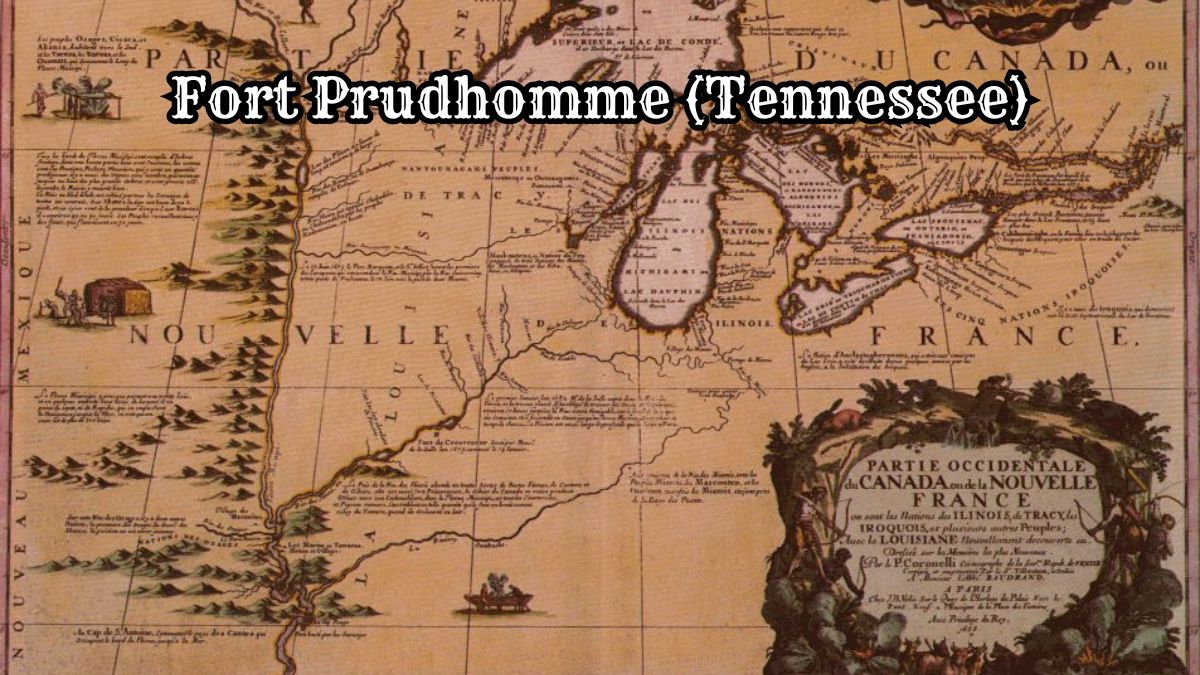The story of Fort Prudhomme begins with LaSalle’s voyage to the Gulf of Mexico, highlighting his party’s journey as they navigated the Mississippi River.
This next narrative in the early history of the United States tells of the first settler near the present site of the city of Memphis, where an Indian village once stood.
Close examination of the narratives and early maps reveals that the first bona fide settlement was at the mouth of the Ohio River, and reputable writers like earlier historian Judge John Haywood documented it.
The agency of French explorers, including Father Hennepin and Hernando de Soto, is evident in the procès verbal of the taking possession of Louisiana.
The historical marker commemorates this phase, with French commanders building the first cabin along the Forked Deer River.
The public has a keener interest in these events, from the first act of formal possession to the full account of Bienville’s expedition, shaping the much-disputed question of the first Anglo-American settlement along the Indian Trail and First Bluff.
The Civil War era further underscores this colony of settlers’ historical significance.
Historical Significance of Fort Prudhomme
Fort Prudhomme was pivotal in French colonial history, particularly in the Mississippi River basin.
Built by the French explorer Sieur de La Salle, this fort marked crucial interactions with Native American tribes, including the Chickasaw Indians, influencing the history of Louisiana.
Origins and Founding

Fort Prudhomme was established in 1682 by Pierre Prudhomme, a Sieur de La Salle expedition member.
Located near present-day Memphis, Tennessee, it served as the first structure built by Europeans in the region.
Its primary function was to provide a temporary haven for La Salle and his men as they explored the Mississippi River.
La Salle’s expedition signified the French agency’s exploration of and eventually colonization of the Mississippi River basin.
The strategic location of Fort Prudhomme underscored its importance in securing French claims and facilitating further explorations.
Role in French Colonial Expansion
Fort Prudhomme became a linchpin in the French colonial network along the Mississippi River.
It acted as a supply and communication post, bolstering the French presence in the newly claimed territories.
This fort was part of a broader strategy to link French territories in Canada with those in Louisiana.
The establishment of Fort Prudhomme helped solidify French control over the Mississippi River, reinforcing their claims against competing European powers.
It also enabled further colonization efforts, contributing significantly to the historical landscape of Louisiana and its surrounding areas.
Interactions with the Chickasaw Indians
The French explorers at Fort Prudhomme engaged in important interactions with the Chickasaw Indians.
These encounters were often marked by diplomacy and trade, although they sometimes led to conflicts.
The Chickasaw were initially allies, providing crucial support and acting as guides during the French expeditions.
The relationship between the French and the Chickasaw was complex, influencing regional dynamics.
The fort served as a point of contact where the exchange of goods and knowledge occurred, impacting the cultural and political landscape of the region.
Fort Prudhomme’s Location
Fort Prudhomme’s location and surroundings were pivotal for its historical importance. Two major aspects were its strategic position on the Chickasaw Bluffs and the critical role of the Mississippi River.
Strategic Location on the Chickasaw Bluffs
Fort Prudhomme was advantageously positioned on the Fourth Chickasaw Bluff.
The Chickasaw Bluffs are four high-ground locations along the eastern bank of the Mississippi River in West Tennessee.
These bluffs provided defensible positions and were less prone to flooding, making them ideal for establishing a fort.
The elevated position allowed for surveillance of the surrounding area and incoming river traffic.
This enhanced security and control over river access were crucial during conflict.
Significant points of these bluffs, such as the Second Chickasaw Bluff and the First Chickasaw Bluff, played important roles in various historical events.
Being on the Fourth Chickasaw Bluff gave Fort Prudhomme a distinct geographic advantage compared to other locations.
Significance of the Mississippi River
The Mississippi River, part of the extensive Mississippi River Basin, played a significant role in the fort’s establishment and operations.
This river is one of North America’s most important waterways for trade, transport, and strategic military positioning.
Fort Prudhomme benefited from its proximity to the river, offering easy access to transport and supply routes.
The river’s vast network connected the fort to other regions, facilitating communication and trade.
Control over sections of the Mississippi River, especially near the Lower Chickasaw Bluff, allowed for monitoring and controlling river traffic.
This strategic advantage was vital for trade regulation, military logistics, and maintaining power in the region.
The Mississippi River’s geographical and economic significance made Fort Prudhomme a vital installation during its time.
Military Engagements and Fortifications
Fort Prudhomme played a significant role during the Indian War, evolving from a simple stockade fortification into a more complex military structure.
The transition from basic to advanced fortifications highlights strategic changes over time.
The Fort’s Role During the Indian War
During the Indian War, Fort Prudhomme served as a strategic defensive position.
Its primary function was to protect settlers and troops from Native American raids. With increasing tensions, the fort became crucial for military planning and coordination.
Fort Prudhomme was part of a network of forts, including Fort Loudoun and Fort Assumption, offering a line of defense.
These forts provided secure locations for storing supplies and hosting troops. Skirmishes and larger confrontations often centered around these fortified points.
Key engagements included numerous skirmishes that tested the resilience and strategic importance of Fort Prudhomme.
The fort’s presence contributed to the control of the surrounding region and played a crucial role in the broader military strategy against Native forces.
Evolution from Stockade to Forts
Initially, Fort Prudhomme began as a simple stockade, featuring basic wooden structures for quick and immediate defense.
Over time, as threats increased, the need for more robust fortifications became evident. This led to the transformation of the stockade into a fortified military complex.
The structures were enhanced with stronger wooden walls reinforced by earthworks. Defensive measures included the addition of gun ports and elevated watchtowers.
These changes improved the fort’s ability to withstand attacks and provided better protection for its occupants.
The evolution mirrored advancements in nearby forts, such as Fort Worth and Fort Loudoun, where similar improvements were made.
The transition from stockade to a fortified complex illustrates the strategic shift in military architecture and defense capabilities during the period.
Explore More: Army Forts in Tennessee
Cultural and Historical Narratives
Fort Prudhomme carries a significant place in history, with diverse accounts from early settlers and substantial documentation in legal and historical texts.
Legends and Accounts of Early Settlers
The identity of the first settler at Fort Prudhomme is often attributed to Henri de Tonti, an associate of René-Robert Cavelier, Sieur de La Salle.
La Salle’s voyage along the Mississippi River in 1682 included an encounter that led to the fort’s establishment.
Stories recount how La Salle and his men built the fort while searching for a lost party member. These narratives have been passed down through generations, influencing cultural perceptions of the fort.
Historiography and Documentation
Detailed investigations of La Salle’s expeditions have been documented through various historical texts and legal documents.
La Salle’s journey is well-recorded, in chronological order, and through artifacts like original items discovered on site.
These documents help to construct a detailed and factual history of Fort Prudhomme, supported by legal records and early settler accounts.
Explore More: 21 Historic Forts of Tennessee
Modern Legacy and Commemoration
Fort Prudhomme has left a lasting mark in history, and its significance is acknowledged through various public displays and educational resources. These efforts highlight its historical impact and place within local heritage.
Historical Markers and Tourism
Shelby County and Downtown Memphis feature prominent historical markers commemorating Fort Prudhomme and its importance in regional history.
These markers serve as educational tools for residents and visitors, providing insight into the early exploration and settlement period.
Locations like the site of Fort Pillow are included in local tours, drawing attention to Fort Prudhomme’s role.
The Tennessee Encyclopedia of History provides detailed entries about these markers, ensuring the fort’s legacy is accessible to the public.
Efforts to preserve and promote these sites have boosted local tourism, adding a historical dimension to the region’s attractions.

Cory is a website owner and content creator who enjoys fishing, history, coin collecting, and sports, among other hobbies. He is a husband and father of four.
Romans 15:4 For whatever was written in former days was written for our instruction, that through endurance and through the encouragement of the Scriptures we might have hope.

